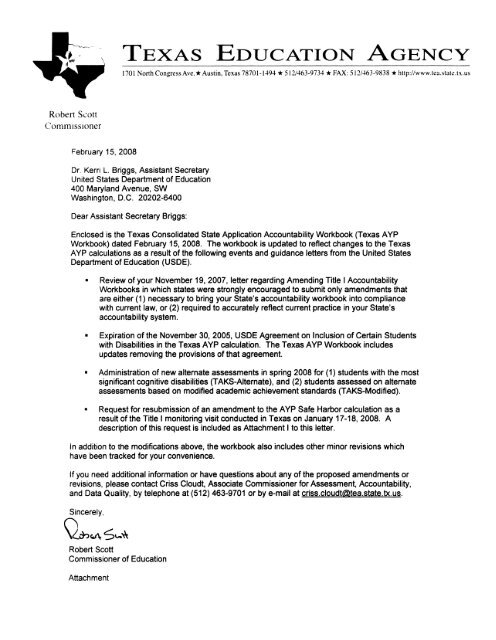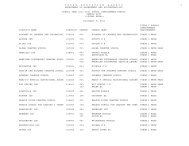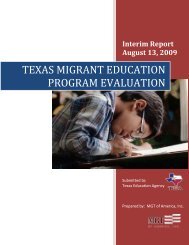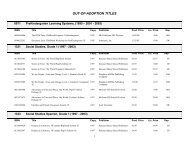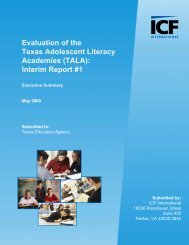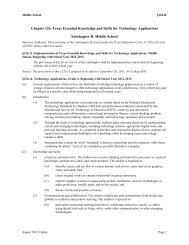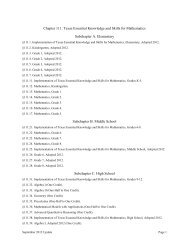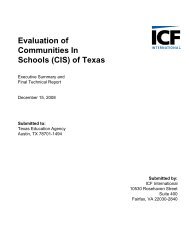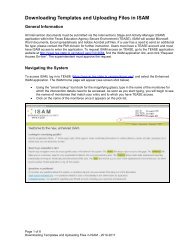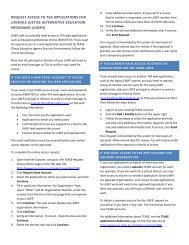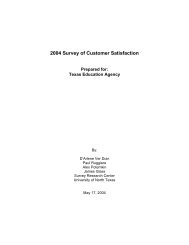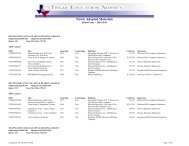Uhc.A 6v. - TEA - Home School Information - Texas Education Agency
Uhc.A 6v. - TEA - Home School Information - Texas Education Agency
Uhc.A 6v. - TEA - Home School Information - Texas Education Agency
You also want an ePaper? Increase the reach of your titles
YUMPU automatically turns print PDFs into web optimized ePapers that Google loves.
TEXAS EDUCATION AGENCY<br />
1701 North Congress Ave. * Austin, <strong>Texas</strong> 78701-1494 * 512/463-9734 * FAX: 512/463-9838 * http://www.tea.state.tx.us<br />
Robert Scott<br />
L~ommlSSl0ner<br />
February 15, 2008<br />
Dr. Kerri L. Briggs, Assistant Secretary<br />
United States Department of <strong>Education</strong><br />
400 Maryland Avenue, SW<br />
Washington, D.C. 20202-6400<br />
Dear Assistant Secretary Briggs:<br />
Enclosed is the <strong>Texas</strong> Consolidated State Application Accountability Workbook (<strong>Texas</strong> AYP<br />
Workbook) dated February 15, 2008. The workbook is updated to reflect changes to the <strong>Texas</strong><br />
AYP calculations as a result of the following events and guidance letters from the United States<br />
Department of <strong>Education</strong> (USDE).<br />
• Review of your November 19,2007, letter regarding Amending Title I Accountability<br />
Workbooks in which states were strongly encouraged to submit only amendments that<br />
are either (1) necessary to bring your State's accountability workbook into compliance<br />
with current law, or (2) required to accurately reflect current practice in your State's<br />
accountability system.<br />
• Expiration of the November 30, 2005, USDE Agreement on Inclusion of Certain Students<br />
with Disabilities in the <strong>Texas</strong> AYP calculation. The <strong>Texas</strong> AYP Workbook includes<br />
updates removing the provisions of that agreement.<br />
• Administration of new alternate assessments in spring 2008 for (1) students with the most<br />
significant cognitive disabilities (TAKS-Alternate), and (2) students assessed on alternate<br />
assessments based on modified academic achievement standards (TAKS-Modified).<br />
• Request for resubmission of an amendment to the AYP Safe Harbor calculation as a<br />
result of the Title I monitoring visit conducted in <strong>Texas</strong> on January 17-18, 2008. A<br />
description of this request is included as Attachment I to this letter.<br />
in addition to the modifications above, the workbook also includes other minor revisions which<br />
have been tracked for your convenience.<br />
If you need additional information or have questions about any of the proposed amendments or<br />
revisions, please contact Criss Cloudt, Associate Commissioner for Assessment, Accountability,<br />
and Data Quality, by telephone at (512) 463-9701 or bye-mail at criss.cloudt@tea.state.tx.us.<br />
Sincerely,<br />
\'<strong>Uhc</strong>.A <strong>6v</strong>.~<br />
Robert Scott<br />
Commissioner of <strong>Education</strong><br />
Attachment
Attachment <br />
Request for Amendments to the <strong>Texas</strong> AYP Workbook for 2008 <br />
(Consolidated State Application Accountability Workbook)<br />
Safe Harbor Improvement on Other Measure<br />
Background/Issue: The AYP safe harbor provisions require that districts, charters, and<br />
campuses show improvement for the student group on the other measure (Graduation<br />
Rate or Attendance Rate) in addition to the improvement on the performance measure for<br />
the subject. This requirement is having the unintended consequence of preventing<br />
districts, charters, and campuses with high performance on the other measure from<br />
meeting safe harbor, even when they show exceptional performance gains for the student<br />
group in the subject. In this situation, even the best districts, charters, and campuses will<br />
see some years that the other measure fails to improve due to chance yearly fluctuations<br />
in the other measure data.<br />
Proposed Amendment: If a district, charter, or campus meets the absolute standard on the<br />
other measure for all student groups that meet minimum size criteria (in addition to all<br />
students), they do not have to show improvement on the other measure as a condition of<br />
safe harbor.<br />
Justification:<br />
• No Child Left Behind (NCLB) anticipated the situation in which it would be difficult<br />
for a high-performing school to continue showing progress. Consistent with the intent<br />
of NCLB, it is appropriate to apply that provision to safe harbor if high performance<br />
on the other measure is preventing a district, charter, or campus from meeting the<br />
AYP standard related to academic achievement. This provision is found in the<br />
following section of NCLB:<br />
20 USC 6316.1116(b)(1)(C) Application – Subparagraph (A) shall not<br />
apply to a school if almost every student in each group specified in section<br />
1111(b)(2)(C)(v) enrolled in such school is meeting or exceeding the<br />
State’s proficient level of academic achievement.<br />
[Note that section 1111(b)(2)(C)(v) delineates the student groups required<br />
to measure AYP.]<br />
• AYP is based primarily on academic assessments, and the system is not intended to<br />
penalize districts, charters, and campuses with high performance on the other<br />
measure.


